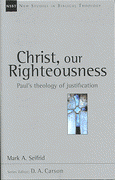First, we note the phrase “no one is able.” The verb “to come” (evlqei/n) is filling out the verb dunatai, which is what you always expect: even in English when we say “able” we follow it with an infinitival phrase, “to do something.” In this case, it is a negation, “no one is able to come to Me.” Is there a context to “coming” to Christ in the preceding verses? Most assuredly. The present participle of this verb appears in John 6:35 in the phrase “the one coming to Me will not hunger.” The present participle emphasizes on-going action. In the same way, the present participle is again found in John 6:37 in the phrase “the one coming to Me I will certainly not cast out.” This appears right after a closely related term is used in the phrase “All that the Father gives Me will come to Me.” It is important to note the contextual flow here, for this provides the context of the use of “coming” in 6:44. In 6:35 Jesus speaks of the one who comes to Him finding in Him true spiritual food; but in 6:36 He says these men are not so coming to Him, but are, instead, unbelievers. John 6:37ff must be read in light of the fact that Jesus has just identified these men who have listened to Him preach all the preceding day, and had wanted to make Him King, and who then followed Him across the lake, as unbelievers. They will, He knew, walk away at the end of the day. He contrasts their unbelief with those who are coming to Him, believing in Him, gazing upon Him (all present tense, on-going verbal actions in the text). So then, we must see 6:44 continuing the thought of 6:37-40, with 41-42 providing a descriptive interlude of the grumbling of the Jews over the claims of Christ, leading to further explanation of why it is that these unbelievers are not believing in/coming to Christ.
We should also note the use of “coming” in the immediately following verse, 6:45, where the Lord expands upon the thought of 6:44 and supports His teaching from the Scriptures. He interprets the teaching activity of God (Isa. 54:13) in a sovereign sense: every one hearing from the Father and learning (= drawn by the Father) is “coming” (present indicative) to Christ–connecting those who are given by the Father to the Son with those who are drawn by the Father/hear from/are taught by the Father (37, 44, 45).
So, it is very true that the only ones who will be raised up on the last day are those who come to Christ; it also just as true that all who come to Christ are those given by the Father to the Son, and that the drawing activity of the Father, then, is likewise limited to those that He has given to the Son. These considerations likewise make somewhat moot the question whether it is the one who comes who is raised up (since the ones who come are, in fact, those given by the Father to the Son, those given life by the Son as well, John 17:2), or whether it is the one drawn, because the two groups are identical in the context of John 6:37-45. But there is still reason to view it differently from the exegetical perspective.
It is simply not natural to read the text so that the “him” who is raised up at the end of the verse is to be defined by the phrase “no one is able to come to Me.” Instead, the natural flow of the grammar and syntax is to define the “him” who is raised up in light of the “him” who is drawn by the Father. This is clearly the sense of the passage: e`lku,sh| auvto,n( kavgw. avnasth,sw auvto.n makes it next to impossible to provide a reason why the one who is drawn is somehow, in such a short space, without any contextual indicator, a different person from the one who is raised up by Christ. This is a much more natural connection, though, as we have seen, in the context of John 6:35ff, it truly makes no difference theologically, for the one who comes is the one given by the Father to the Son (47); the one who is drawn is likewise the one who hears and learns from the Father and is coming to Christ (45). It is only the eisegetical assumption on the part of Arminians and others, like Wilkin, that allows them to read into the text, from later passages in different contexts, that God’s drawing is a mere offering or wooing that does not result in the coming of the ones thus drawn (which is surely not the Lord’s point here), that can create the distinction between the “him” who is drawn and the “him” who is raised up.



